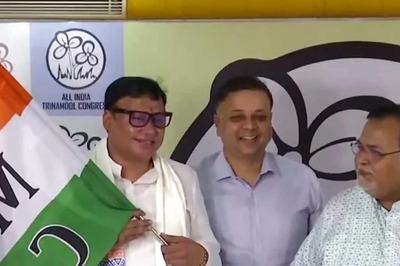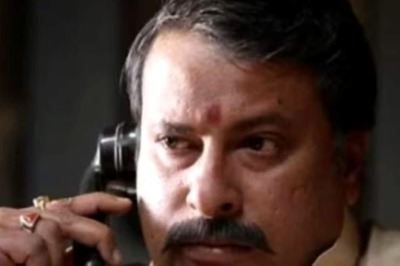
views
The fuming hot cauldron of a godown of Kishore Spices, just across the road from the famous Jew Street in Fort Kochi, is no longer full of pepper. Instead, the hurriedly painted godown houses some radically spicy installations that are part of the Kochi Muziris Biennale which will close down its fourth edition, on March 28, after a four-month run.
The Biennale is awash with installations that are reminders of a coming dystopia or a forgotten catastrophe or the dangers of forgetting the past. Everywhere there are warning signs.
Outside on the walls of the narrow alley as we enter the godown are various metallic old rusted covers of the old electricity meters. We wonder why the space needs so many rusty meters when what it needs is more of pepper.
The meter covers are installations by Progga Paul, who is from the Rabindra Bharti University. Paul is trying to show the “claustrophobic character of the post-colonial city and complexities of everyday existence.”
In a way these terrible looking metallic covers make you ponder. They remind us of the rotten memories of the city-life and those of us who have lived in Kolkata know how these run down meters which never transmitted power regularly, were nothing but a reminder of urban dystopias.
Such arresting installations are part of the Biennale curated by the well-known Anita Dube who transformed it into a show of radical politics, reminding us constantly of the exploitation, the unheard cries of lives on the fringes, the struggles of the tribal people to make their voices heard and anti-war epigrams.
Art on display at the Kochi Biennale. Image: Binoo K John
This edition of the Biennale dragged the fringes into the centre. It made us ponder, it made us see, and it made us listen to voice we had never heard before.
Past the Progga Paul metres which electrify our senses in a way, as one enters the godown, a world of colours open to us. A variety of coloured threads are woven or stretched this way and that across a frame. They are unwoven tapestries, soothing but left incomplete, something waiting to be created. They tell a story.
This installation is made by students of the Kokrajar Fine Arts College which was established in 1996 as a part of a move to give Bodo art a distinct identity.
Simay Brahma, Ashok Brahma, Subung Basumatary wanted to “interpret the life of the Bodo women in the background of the changing patterns of modern life.” A Bodo woman is almost always a weaver, in whose mind plays different patterns that she wants to transform into an object of beauty. It is also an expression of her aspirations. In those beautiful pre-tapestry threads, we can see her imagination.
New York based Martha Rosler, a well-known name in the feminist art movement, uses her photomontages, videos and installation to focus on the atrocities committed in the world by the US. Her anti -Vietnam graphic series has now been restarted to show the fall-out of the Iraq, Afghanistan wars by the US. In the first floor of Aspinwall House, Rosler’s images are intended to remind us that we need to get out of the comfort zone into which dominant media traps us.
Self-taught artist Vipin Dhanurdharan’s portraits recreate the history of Kerala’s social reform movements. He stayed with people in the fringes of society and produced completely arresting portraits which are not ashamed to show off its basic qualities, devoid of many of the western portraitures painting techniques or its finishing styles.
Dhanurdharan’s portraits at the Biennale. Image: Binoo K. John
“It was when I was reading about Sahodharan Ayappan’s movement that I got this idea. Anita Dube had seen my work at a show here and she liked the idea of this series of portraits,” Dhanudharan told this reporter.
In the ground floor room of the Aspinwall House, the self-taught artist’s portraits of the poor remind us of forgotten lives and in an act of utter defiance he titles them all as Sahodaran (brother) or Sahodari (sister) and makes them sit amidst us so that we can listen to their unheard stories.
Next to that room Dhanurdharan has also put up a canteen where visitors can go and make their own tea, coffee or kanji (rice gruel). The community kitchen is a stark throwback to 1917 when Ayappan held the first “misrabhojanam” or communal eating function in Cherai a beach town about 40 kms from Aspinwall House.
Bangaluru artists B.V Suresh’s dark room is dystopia itself with signs of fallen things and the room itself surrounded by canes or lathis beating itself into the ground, making a grim chorus – a reminder of the present times where many freedoms are being curtailed.
He calls it the “absurd theatre of politics.”
Further down in a garage F.B Itso of Denmark has hung a huge tyre used in heavy cranes to show the plight of Kerala’s rubber farmers - some of whom committed suicide.
F.B Itso's tyre installation. Image: Binoo K. John
Everywhere our attention is drawn to the fringes or the people who dropped out and were pushed to the fringes. As if in revenge their stories and their plight are bought to the centre stage.
Every war be it Vietnam or Afghanistan is condemned and the march of the military is always a warning. The 95 artists who showcased their work attempted to showcase the aesthetics of the radical voice. It was a Biennale of dystopian warnings.




















Comments
0 comment